Public Health Preparedness Program
Mission: To prepare and respond to natural and man-made public health emergencies including, but not limited to:
- severe weather conditions
- bioterrorism
- disease outbreaks
- radiological/nuclear hazards
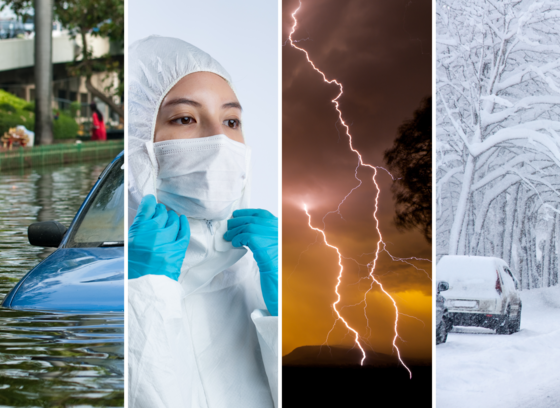
Each month HCHD will bring you information and resources about different hazards and how to be prepared to respond.

December: Winter Weather Preparedness
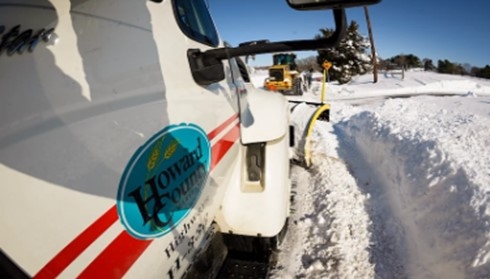
Severe Winter Weather in Maryland is defined by criteria used for Winter Storm Warnings, Ice Storm Warning, Blizzard Warning and other Severe Conditions which can cause hazardous driving conditions.
Winter Storm Warning
- Snow: 5 inches or more of snow/sleet in a 12-hour period, or 7 inches or more in a 24-hour period
- Ice: Enough accumulation to cause damage to trees or power lines
- Combination: A combination of snow and/or ice with wind that can be damaging or life-threatening
Ice Storm Warning
- Ice: Damaging ice accumulations of 1/4 inch or more are expected, which can cause widespread tree damage and power outages
Blizzard Warning
- Wind: Gusts of 35 mph or more
- Snow: Heavy falling or blowing snow that reduces visibility to 1/4 mile or less
- Duration: The conditions last for at least 3 hours
Other Severe Conditions
- Snow Squall Warning: Issued for a short-duration, intense burst of snow and wind that can lead to whiteout conditions and dangerous road hazards like flash freezes.
- Wind Chill Warning: Issued when wind chills are expected to be -35°F or lower
- Black Ice: Thin transparent, and nearly invisible layer of ice that forms on surfaces like roads, making them extremely slippers. Forms when temperatures drop, often in the early morning, and can be particularly treacherous on bridges and shaded areas of the road
PREPARE for Winter Weather at home, work and vehicle
Winter's charm is undeniable, but it also presents serious dangers that require preparation. In areas with cold weather, snow, and ice, plummeting temperatures can lead to hypothermia or frostbite as your body quickly loses heat. Additionally, snowstorms cause significant chaos, bringing icy roads, power outages, and potential loss of communication services. Stay informed and prepare a plan to stay safe.
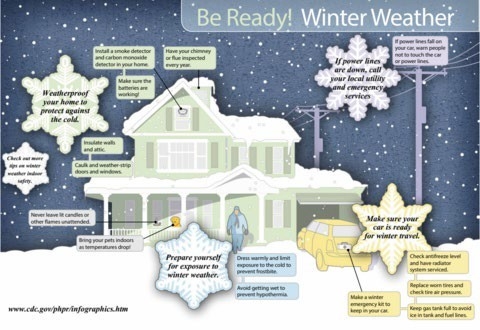
Additional tips on how to protect yourself during severe winter weather.
- Have at least a week’s worth of food and safety supplies (ex: prescriptions medications)
- Prepare an emergency supply kit for your home, car, and work.
- Have or Develop a communication plan with your family for use in an emergency.
- Ensure Pets have adequate shelter to keep warm along with unfrozen water and take inside when temperatures become severely low.
- Check on your neighbors and family to make sure they are okay or if they need help.
- Tune into local news for updates, warnings and advisories from officials.
- Up-to-date weather information can be found on National Weather Service Website.
- Learn the difference between “Watch” and “Warning”
- Avoid alcoholic or caffeinated beverages – they cause your body to lose heat faster.
- Drink warm broth or sweet beverages to provide comfort and boost your mood
- CDC/FEMA Preparing for Winter Weather ASL video
Stay Safe DURING a Winter Storm
Winter storms are dangerous. They can bring cold temperatures, power failures, loss of communication services, and icy roads. This can make being outside dangerous, so you should limit your time outside. Although staying indoors as much as possible can help reduce the risk of car crashes and falls on the ice, you may also face hazards inside your home.
Safety tips for shoveling snow
- Pace yourself: Take breaks every 10–15 minutes to rest and warm up.
- Lift with your legs: Bend your knees and use your legs to lift, not your back.
- Shovel smaller loads: Don't overload your shovel. Lift smaller, lighter loads to reduce strain.
- Stay hydrated: Drink plenty of water before, during, and after shoveling.
- Take frequent breaks: Stop and rest, especially if you feel tired or out of breath.
- Listen to your body: Stop immediately if you experience chest pain, dizziness, or shortness of breath.
- Consider alternatives: Ask a neighbor for help, or use a snow thrower instead of a shovel if possible.
- Consult a doctor: If you have a heart condition or risk factors like high blood pressure, talk to your doctor before shoveling snow.
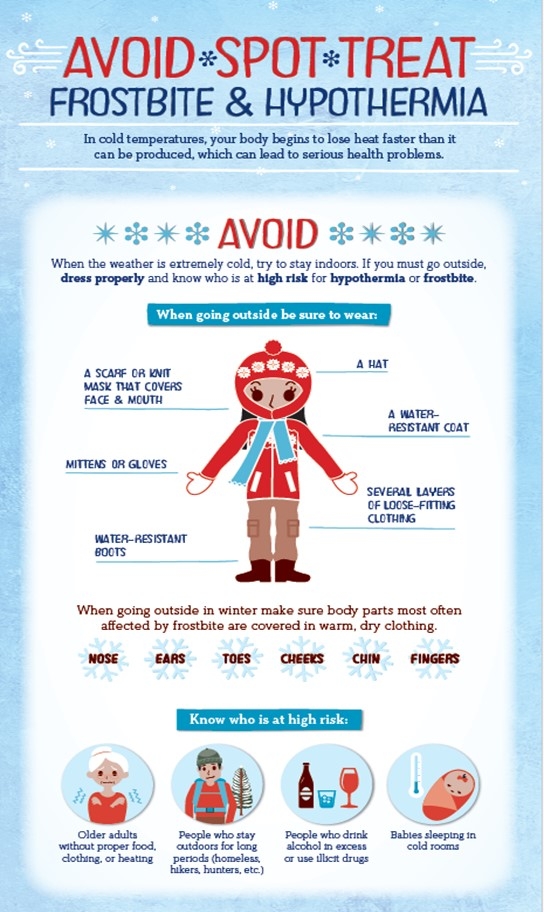
Hypothermia (abnormally low body temperature) and frostbite are both dangerous conditions that can happen when a person is exposed to extremely cold temperatures. Stay safe this winter by learning more about hypothermia and frostbite, including who is most at risk, signs and symptoms, and what to do if someone develops hypothermia or frostbite.
Learn more:
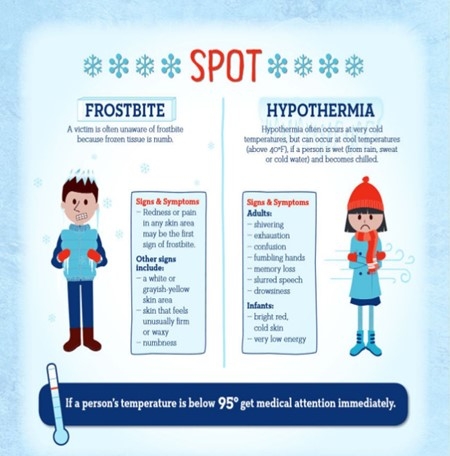
AFTER the Winter Storm
Protect yourself and your loved ones during and after a winter storm. Take extra steps to make sure you heat your home safely.
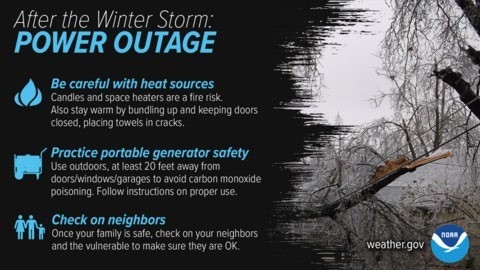
Be Prepared
Additional Resources
Heat/Sun Safety Tips
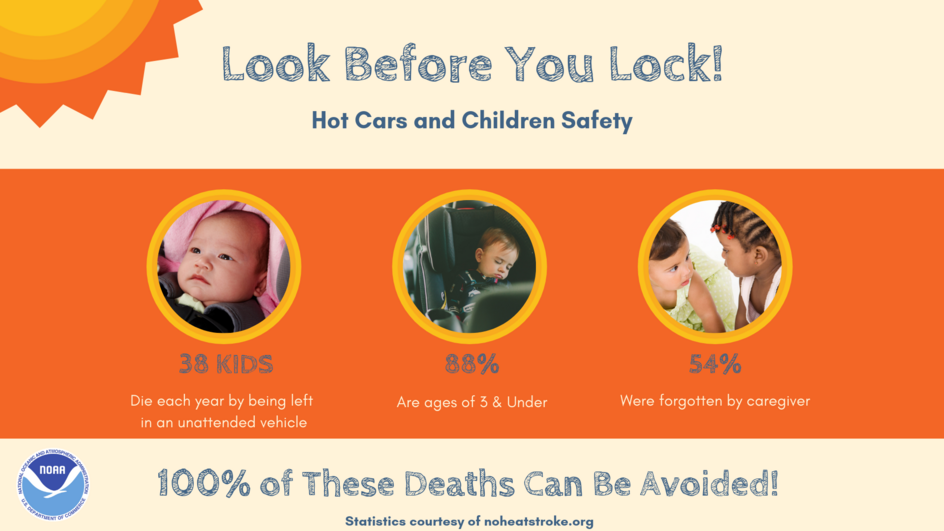
Extreme heat can be dangerous after long periods of exposure, if proper precautions are not taken.
To protect yourself and your loved ones from the dangers posed by prolonged sun and heat exposure, follow the below tips:
- NEVER leave children or pets unattended in a parked car or other hot environment.
- If you must be outside in the heat, wear light-colored, lightweight, loose-fitting clothing, a hat and sunscreen.
- Stay hydrated. Drink water and caffeine-free liquids. Alcoholic beverages do not keep you hydrated.
- Take frequent rest breaks in air-conditioned or shaded areas if you must work or exercise outdoors. If possible, stay out of the sun during the middle of the day.
- Know the signs of heat-related illness, including: extreme weakness, muscle cramps, nausea, headache, vomiting, fainting, dry/red skin.
- Check regularly on infants, elderly, family and neighbors with health conditions as they are more vulnerable to heat-related illness.
- If planning a trip to the lake/beach/pool to cool off, be sure to review swim and water safety guidelines with your family and children
Additional Resources about Heat/Sun Safety:
- NHTSA Prevent Hot Car Deaths
- CDC Sun Safety
- American Academy of Pediatrics Drowning Prevention
- National Weather Service Heat Safety
- Heat.gov
- Heat Emergency Awareness: Hot Weather Tips and Heat-Related Illnesses
Places to cool off on a hot day (contact location to verify operating hours before visiting)
- Howard County Library System Branches
- Howard County 50+ Centers
- Howard County Recreation & Parks Community Centers
- The Mall in Columbia
- Map of Howard County Cooling Centers
Anyone in need of shelter or other assistance should call the Grassroots hotline at 410-531-6677 or visit grassrootscrisis.org.
Maryland Responds Medical Reserve Corps
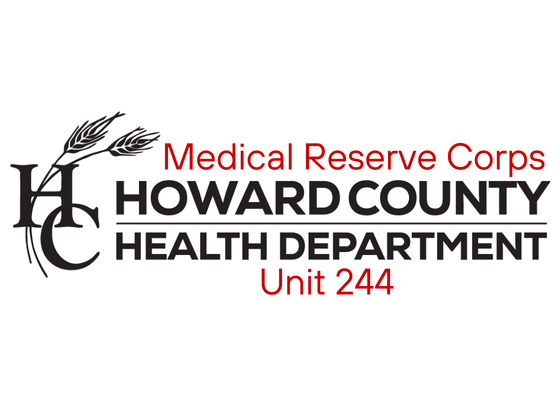
How can YOU help in an emergency?
Become a Public Health Hero - Join the Howard County Medical Reserve Corps
The Howard County Medical Reserve Corps (HCMRC) Program is volunteer organization created in July 2002. Medical Reserve Corps (MRC) volunteers can be medical and public health professionals or community members with no healthcare background.
At A Glance Emergency Contact Information
Howard County Health Department
Phone: 410-313-6300
Maryland Department of Health (MDH)
Phone: 410-767-6500
After Hours Emergency: 410-795-7365
Maryland Emergency Management Agency (MEMA)
Phone: 410-517-3600
Centers for Disease Control and Prevention (CDC)
Phone: 800-232-4636
Hazards of the Month
January Hazard: New Year, New Year, Take Action and Prepare
February Hazard: Power Outage Safety
April Hazard: Flood Preparedness
June Hazard: Thunder, Lightning, Hurricanes, & Tornadoes
August Hazard: Back to School Preparedness
September Hazard: Personal & Home Preparedness
October Hazard: Outdoor Awareness
November Hazard: Nuclear & Radiological Preparedness
December Hazard: Winter Weather Preparedness